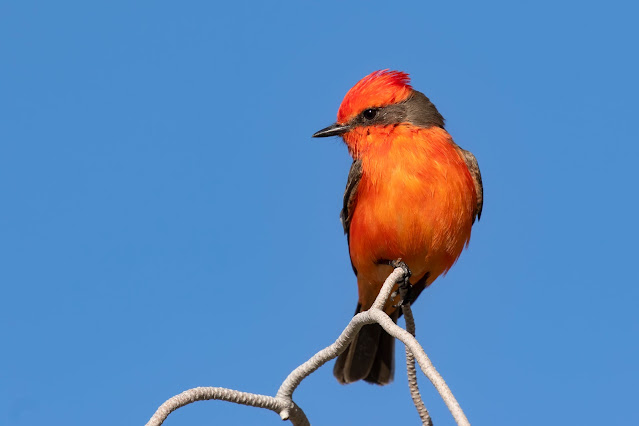Birding at the Arizona State School for the Deaf and the Blind
By Erica Freese

Vermilion Flycatcher by Mick Thompson
The recent Southeast Arizona Birding Festival included an event at the Arizona State School for the Deaf and the Blind (ASDB). It was led by Kim Aikins, a teacher at ASDB and also the President of the new non-profit, Southern Arizona Accessible Wildlife Refuge. We met under a pavilion overlooking a grassy area surrounded by trees and had support from an American Sign Language (ASL) interpreter, a Tucson Audubon volunteer, and a few other aides and teachers. There were a handful of binoculars and a spotting scope for the kids to use, and we brought feathers, a saguaro boot, and a few skulls for them to hold and look at. The students live onsite and had the option to join us for this event at 8 am on a Saturday morning, making it remarkable that 15 students joined us!
One of the first things we pointed out was the Mourning Dove nest in the rafters of the pavilion. There were two doves looking down at us. I joked that adolescent doves look like I, and maybe many of the students, do when first waking up in the morning—hair or feathers going every which way, a little dazed, and not the most awake.
 |
| A good turnout for an early Saturday! Photos by Erica Freese |
 |
| Mourning Dove nest |
A highlight was seeing the resident Red-tailed Hawk and focusing the spotting scope on it. The ability to see the details of these birds, for possibly the first time, was an exciting experience for many. I pulled up the Merlin Bird ID and played the calls of the hawk for the couple of students who are blind or visually impaired. They commented on having heard the sound used in movies (although, in my experience, it’s usually used incorrectly for an eagle…oh, the knowledge that comes with being a birder!). I then played the sounds of the Gila Woodpecker, which they all knew well. They recognized the buzzes and whistles of the Anna’s Hummingbird but hadn’t realized that’s what they had been hearing. Lastly, I played a recording of a Northern Mockingbird. This was definitely the showstopper and the kids couldn’t believe that the myriad of vocalizations all came from one species!
I am proud to say that Tucson Audubon’s mascot, a male Vermilion Flycatcher, showed up for the last 15 minutes of the event. We focused the spotting scope on the perch he consistently returned to after swooping down in search of a meal. Additional birds we saw included Eurasian Collared Dove, House Finch, Gila Woodpecker, Verdin, Lesser Goldfinch, and Barn and Cliff Swallows.
 |
| The resident Red-tailed Hawk |
 |
| Discovering birds for the first time |
I had my camera with me and was able to zoom in on the birds and show the screen to the kids. They were so excited to see the photos on the screen and then be able to point out where they saw them in real life. My sense is that we very often only see beautiful, interesting, and detailed things virtually, so to be able to make that connection to the natural world around you is such a rewarding experience.
Kim rounded out the event by telling the kids about her plan to create a birding club at their school. As a club, they will be able to travel to birding locations around Tucson such as Santa Cruz River Park and Sweetwater Wetlands. Tucson Audubon plans to support this endeavor however we can.
After a morning of birding, the kids went off to eat their Saturday morning pancakes—it doesn’t get much better than that!
Erica Freese is Tucson Audubon’s Grant Development Specialist.

Comments
Post a Comment
Thanks, we value your opinions! Your comment will be reviewed before being published.